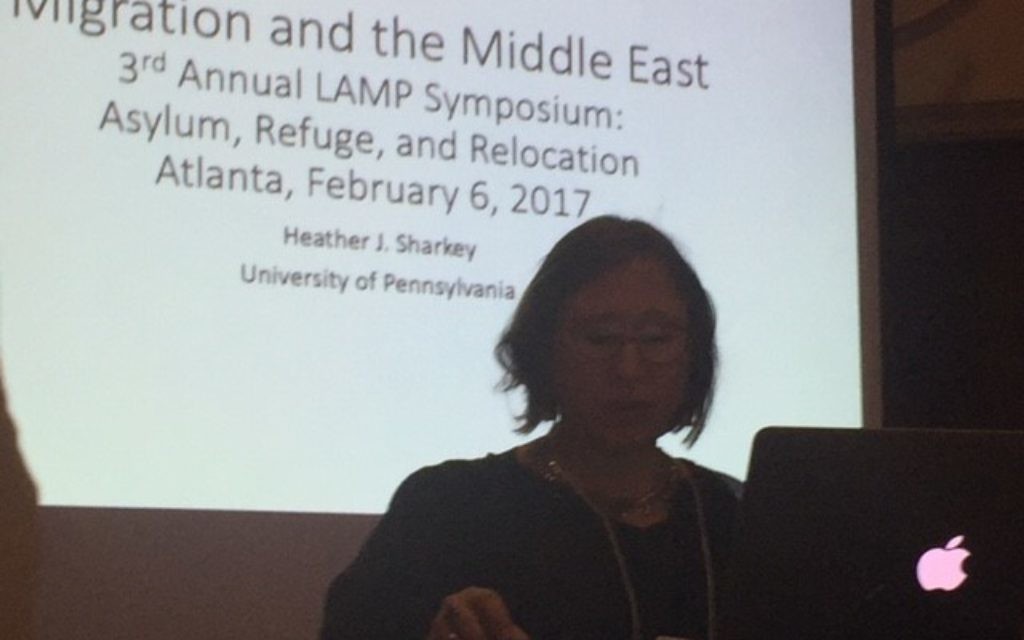Migration Transforms America, Mideast
Symposium Discusses Shift in Migration from Muslim Countries

“Massive shifts in population and human rights have led to a desire for change,” Dean Jacqueline Royster of the Ivan Allen College of Liberal Arts at Georgia Tech said while presenting the third annual Leadership and Multifaith Program Symposium, held in conjunction with the Candler School of Theology at Emory.
Atlanta’s demographics have changed, Royster noted, and this region wants to be the champion of national values, whether regarding race, gender or religion.
To address the shift in migration from Muslim countries and examine the waves of emigration from the Middle East, LAMP presented a workshop on migration and the Middle East that was led by Heather Sharkey of the University of Pennsylvania’s department of Near Eastern language and civilizations.
Get The AJT Newsletter by email and never miss our top stories Free Sign Up
Sharkey, who previously taught at the University of Massachusetts at Amherst, MIT and Trinity College in Connecticut, has written and edited several books involving Muslims, Christians and Jews in the modern Middle East.
In the late 19th century, populations of Chechens, Georgians, Circassians and Tatars were driven out of Crimea by the expansion of Russian power. The displaced people moved to the Middle East and settled in what is now Jordan, Syria, Turkey and Israel, among other countries. Over time, these newcomers assimilated.
Meanwhile, large numbers of immigrants escaped the Ottoman Empire and sought refuge in the Americas, including Mexico, Argentina and Colombia. Pogroms throughout the Russian Empire in the 1800s compelled Jewish communities to relocate to Iran, Iraq, Turkey and Morocco.
Few of those nations required passports in the 19th century, but immigration policies became far stricter after World War II, setting tighter barriers against Asians and Middle Easterners.
Various factors, including religious and sectarian tensions, contributed to the movement of these populations. Among them were Jews who experienced strains in relationships with their Muslim neighbors.
Deteriorating economic conditions in the Ottoman Empire and land shortages led to further surges of immigration, including 1.2 million people trying to avoid being drafted into the military, Sharkey said. Single women who relocated after 1900 were seeking employment and prospective husbands overseas.
In due course, American and Middle Eastern experiences became intertwined, and American authors such as Mark Twain sought to counteract Orientalism with books such as “The Innocents Abroad.” People from the Middle East, such as Lebanese-American artist, writer and poet Kahlil Gibran and Sufi poets Hafez and Rumi, shared their culture through stories about immigration.
“Much of the Middle East’s landscape has changed over time,” Sharkey said, as has its influence.
Dubai, for example, has become a thriving metropolis among vast desert dunes. After the Iranian revolution in 1979, Los Angeles experienced waves of Persian immigrants who brought their culture and traditions.
Pop songs have become popular among Persian-Americans, despite the Iranian government’s distaste for the music in Tehran, but Sharkey joked that it was rather cheesy.
Following in the footsteps of Jewish peddlers, people from all over the globe arrived in the United States and spread across the American landscape as artisans, carpenters and restaurant owners.
Not everyone who immigrated to the United States settled, however; many returned home because of lost jobs or national quotas such as the Johnson-Reed Act in 1924 and the Hart-Celler Act in 1965.
Those who were most violently uprooted, however, remained in their new land. “Global interconnectedness between the Middle East and America weaved a rich tapestry of pride and conviction for one’s culture,” Sharkey said, and that’s important to remember moving forward.
“The past is usable to us in that it tells us where we have been and where are we going,” she said. “The past offers a sense of comfort and experience in understanding how our country’s history is intertwined.”




comments